The small city of Sighisoara, Romania is one of the most popular places to travel in the historic region of Transylvania. Medieval towers, unique local culture and a picturesque old town draw visitors from around the world.

Travel to Sighisoara, like much of Transylvania, is a tour through the region’s unique blend of ethnic groups. Groups who have called Sighisoara home include Hungarians, Germans and, of course, Romanians.
While other cities in this part of Romania may be more notorious for their Transylvanian heritage, I find it stands out more in Sighisoara. Despite most of the ethnic Germans and Hungarians leaving over the last century, small populations still reside here. It’s not uncommon to see signs in the city in three languages. Although Romanian culture dominates today, the visible impact of the Hungarians and Germans over the last few hundred years is unmissable.
Sighisoara’s culture and history is certainly a worthwhile reason to visit the city, but the main attraction to travel here is to explore the time capsule that is the Old Town, the Historic City Center. Here are the top attractions, the best things to do and everything you need to know about travel to Sighishoara, Romania:
Highlights and Things to Do
Sighisoara can be roughly separated into two parts: the medieval old city and the surrounding “modern” city.
The Historic Center of Sighisoara, a UNESCO-designated site, is a medieval fortress town marked by walls and towers. It is essentially the high ground, with an even higher hill in the middle that looks down over the ‘newer’ city and the surrounding countryside.

The rest of Sighisoara is largely old buildings from the 1800s to the early 20th Century. There are a few modern structures in the mix. Strangely, Communist era architecture is not especially prominent. In this sense, Sighisoara is lucky. For that matter, we’re all lucky that this piece of Transylvanian heritage survived the Romanian Communist era.
The Historic Center of Sighisoara
The Historic Center of Sighisoara sits atop a hill that originally served as a citadel. With the advantage of the high ground and magnificent views, the location is ideal for a fortress in that era.
Today, the Historic Center of Sighisoara is a wonderfully well-preserved old town. From the cobblestone streets (they’re old, so watch your step!) to the colorful buildings, historic churches, medieval towers and walls, it’s easy to see why Sighisoara’s Historic Center is a UNESCO-designated site.

Walking through Old Town is a stroll through a living, breathing postcard. After you walk up the hill – and walking is pretty much how you’ll have to get there – there’s a picturesque scene awaiting around each corner.
The Historic Center of Sighisoara is small, but this is where you’ll find most points of interest.
The Towers of Sighisoara
Sighisoara’s most famous landmarks include its medieval towers. There are nine remaining towers (of 14 originally) you can see, and you can visit most of them.

The towers that survive today are part of the reason the Historic Center of Sighisoara is so unique. In many old cities, the surviving medieval walls, towers and other structures have been absorbed and become part of the modern cityscape. At times, these structures are unrecognizable. The medieval citadel of Sighisoara is still very much visible.
The most striking and prominent tower is the Clock Tower, Turnul cu Ceas. Visiting the Sighisoara Clock Tower is one of the best things to do when you travel to Transylvania.

A visit costs 28 Romanian Lei (about $6 USD as of March 2023). This is the price to visit the tower and the adjacent prison/torture museum. There isn’t much to see there, so I suggest paying only to visit the tower. The tower appears to, well, tower over everything else, but the climb to the top isn’t as difficult as it looks. There are exhibits all the way up with a lot of information (mostly in Romanian, though). Note: The Clock Tower has short hours and is closed on Mondays**
At the top, the view of Old Town is spectacular. The view over the rest of the city is equally great. The perspective of other towers and buildings is unique. This is definitely something you do not want to miss when visiting Sighisoara.

Most of the other towers are open to the public, though one or two are on private property and not accessible. Of note, the Tinsmiths’ Tower is definitely not open to the public. The other towers are worth a visit (if/when they are open). There is a lot of history and unique views with each one.
Piata Cetati
Piata Cetati (Citadel Square in English) is the main town square of the old city. Naturally, this is the de facto center of Old Town Sighisoara.

It is a small square. There are several restaurants, a few souvenir shops, a couple of points of interest and a nice view of the area. This is a good spot to find a bench and take in the scene. The restaurants in Citadel Square are also a great place to stop for a break, and I strongly recommend taking the time for a meal or drink here.
Churches of Sighisoara
There are three notable churches in Sighisoara’s Old Town. Interestingly, none of them are Romanian Orthodox churches. Despite Romania being an overwhelmingly Orthodox nation today, the Historic Center of Sighisoara remains true to the local history in this respect.
The most prominent church in the city is the Church on the Hill (Biserica din Deal). Sighisoara’s Church on the Hill sits at the highest point of the old city, visible across the city and from many miles away. It dates back to the 1400s and is the most historically significant church in Sighisoara.
The Church on the Hill
The Church on the Hill is remarkable in appearance and position. It is very Transylvanian in design – that is, it’s definitely German in appearance – and stands like a beacon to local history. Like most Lutheran churches in Transylvania, it functions more as a museum today.
I have a thing about paying to enter churches. I was prepared to enter this one, but it turns out it costs to enter and was closed anyway. Despite that, perhaps this is an exception I will make when I return to Sighisoara. There is a lot of history here, and it may be worth the small price of admission on this occasion.

Aside from entrance to the church, the location is worth the hike up the hill. And there is an historic cemetery adjacent to this church. If you’re into this sort of thing, cemeteries can be beautiful, intriguing places to visit. This one is full of history and almost entirely consists of German names on the headstones. It’s a great, unique way to explore the local history.
The Church of the Dominican Monastery
The most visible church when you are in Old Town is the Biserica Masastirii Dominicane, the Monastery Church or the Church of the Dominican Monastery. It sits near Citadel Square and the Clock Tower, right by the edge of the citadel walls.

This is a large Lutheran Church. In true Lutheran fashion, there isn’t a lot happening on the exterior of the church. It’s a nice church, and it’s prominent. But it is fairly simplistic. The interior also seems to be fairly Lutheran, but, unfortunately, it was not open during my time in Sighisoara.
St. Joseph’s Cathedral
Catedrala Sfantul Iosif, Saint Joseph’s Cathedral, is the Roman Catholic church in Sighisoara’s Historic Center. This small Catholic church sits on the north side of the Citadel, with sweeping views of the city, valley and mountains in the distance.
Curiously, the smallest of the three churches in Old Town is the Catholic one. Today’s ethnic minority of Hungarians (Catholics) is considerably larger than the remaining population of ethnic Germans (Lutherans). However, that is one of the things that makes Sighisoara such an remarkable place to visit. It’s about the history; historically, there were a lot of Germans.

St. Joseph’s Cathedral is fairly small. It is quiet, simple and entrance is free. At least, I think entrance is free. I walked right inside. There were a couple of people working inside who looked at me curiously, but did not seem to mind that I was looking around. This church is different than a lot of Catholic churches I’ve visited in Europe. It has a simple interior. There isn’t much to see inside, but it’s a nice place to visit.
Holy Trinity Church
When mentioning churches in Romania, it’s hard to ignore the Romanian Orthodox churches that dominate most of the country. The Romanian Orthodox Cathedral of Sighisoara, Biserica Sfanta Treime or Holy Trinity Church, is an unmissable landmark in the city.

Sitting on the bank of the small Tarnava Mare River that runs through the city, the Holy Trinity Church rises above all nearby structures. As an Orthodox church, it stands out, too. It’s not very old, but take the chance if you have the opportunity to visit. Romanian Orthodox churches are stunning inside and out.
Enjoy a Walk through History
With fewer than 30,000 people, Sighisoara is a small city. The Historic Center is even smaller. Despite the small size, it is easy to spend hours wandering around the old town.
I cannot stress how pretty the scenes in the old town are. It really is one of those places where you cannot help but take a picture around every corner. As you wander around looking at the picturesque old buildings and towers, you will suddenly come across a great viewpoint. These are all around the Historic Center.

Away from the old city, “modern” Sighisoara is worth a wander, too. Parts of the area are starkly different from the scenes of the citadel. There are structures from the Communist era and others that are more typical of Romanian life in small cities, neither modern, Communist nor medieval.

The main reason to stray from the Historic Center of Sighisoara is to see what the city is like away from the tourist bubble. It’s not as photogenic as Old Town, though there are places with great views looking back at the citadel.
It’s important to remember that life in places we travel exists away from tourist sites, and you can see this here. This is also a great way to find local places to stop and have a drink or bite to eat on the cheap.
The Scholars’ Stairs
The Scholars’ Stairs is essentially a stairway. It connects the lower part of Old Town to the Church on the Hill and dates back to the 1600s.
The 176 steps are covered by a wooden shelter, presumably to protect churchgoers from the elements in the past. There isn’t a lot to these stairs, but it is an important landmark of the city. And it’s cool that these steps have survived so long.

Also, how often do you get the chance to walk up a notable, medieval set of stairs? That’s something, right? Whether or not the Scholars’ Stairs is worth the recognition it receives, it’s the best way to reach the Church on the Hill, adjacent cemetery and great view at the top.
Hilltop Viewpoint
As mentioned several times already, there are spectacular views of Sighisoara and the surrounding area from various places atop the medieval citadel of Old Town. However, my favorite viewpoint in and of Sighisoara is a hill across from the Historic Center.
I love finding a good view. My favorite viewpoints are those without crowds. When I walked to this hilltop viewpoint, there were only two other people. In a delightful turn of events, the couple insisted I join them.

They spoke a little English, and it turns out they are both ethnic Germans, one Swabian and one Saxon. The man was born in Sighisoara but emigrated with his family to Germany when Ceausescu and Communist Romania fell. His wife was from another area of Transylvania. They were back to visit a few family members and see their home. The couple was also kind enough to share some local knowledge of how the area has changed in the last 30 years.
This was a fascinating encounter for myself, and it was another example of the wonderful travel lesson of “you never know who you might meet.”
This empty hill has a tremendous panoramic view looking back at the Historic Center of Sighisoara. You can find it on Google Maps called “mic punct de belvedere,” which translates to “small viewpoint.” It takes about 20-30 minutes to reach this hill from the Old Town. The directions on Google Maps are accurate.
Vlad the Impaler’s (Dracula) House
It’s hard to escape the Dracula narrative in Romania, especially in Transylvania. This is understandable. It’s a significant driver of tourism. And the same can be said for Sighisoara.
The significance of Vlad the Impaler in Sighisoara is that the house in which he was (supposedly) born is in the Historic Center. There is a lack of concrete evidence that Vlad was indeed born in Sighisoara, much less in this specific house. However, it is known that his father was here when little Vlad was born.
Despite the uncertainty, this is the commonly accepted site of Vlad the Impaler’s birth and early years. Dracula association aside, Vlad is a fascinating historical figure. This building is one of the oldest in Sighisoara, too. I do not suggest paying to visit the small museum, but it is a historical site nonetheless.
Eating in Sighisoara
Eating in Sighisoara is a fun way to get a taste for Romanian history, particularly the local history in Transylvania. It does not come without its challenges, though.
Sighisoara can be broken up into two distinct areas to eat: Lower Town and the Historic Old Town. Old Town has restaurants scattered throughout the area, but the primary concentration is in the main square. This is an excellent spot to grab a bite to eat in a picturesque, historic setting. These restaurants are pretty good, too, and prices are cheaper than many of the newer, trendier restaurants in the city below.
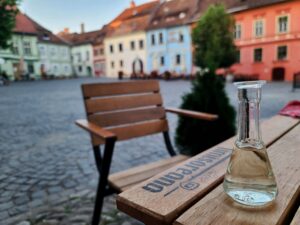
Overall, eating in Sighisoara is not much different from eating in other popular Transylvanian cities, such as Sibiu. Modern Romanian is the most common cuisine. The difference in Sighisoara is that elements of other historic ethnic groups are slightly more visible.
History through Food
Food in Sighisoara restaurants is a reflection of modern-day Transylvania. There are, of course, usual Romanian dishes on most menus. German history is noted in some of the food, but the larger (remaining) Hungarian minority has a more visible representation in local cuisine.
Langos, a fried flatbread, is sold in several spots around Sighisoara. Goulash, another Hungarian staple, is a common sight on menus.
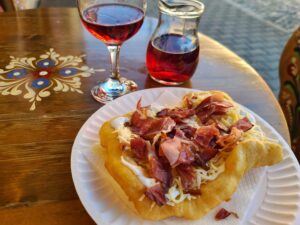
Aside from a few Hungarian and German influences, Romanian food dominates most menus. You won’t have any issue finding delicious, local food for a good price.
Challenges of Eating in Sighisoara
The challenges of eating in Sighisoara are the times and options. Old Town is extremely tourism-dependent. When there are fewer tourists in the offseason or during the middle of the week, restaurants tend to close earlier or not open at all.
You needn’t worry about finding a place to eat, but don’t expect to not see a full slate of options at all times. More info on when to visit Sighisoara below.
The other challenge of eating in Sighisoara is away, or rather below, from the Historic Old Town. The highest concentration of restaurants in Sighisoara is in the area at the base of the Citadel, essentially on the same level as most of the city.
There are a lot of restaurants in this area, but the options are mixed. A few cheap spots and a few places with good local food are more difficult to locate among countless trendy spots, pricier tourist cafes and Italian restaurants.
To be fair, food in the lower town is still pretty affordable, and this is where you can find the few truly cheap places to eat in Sighisoara.
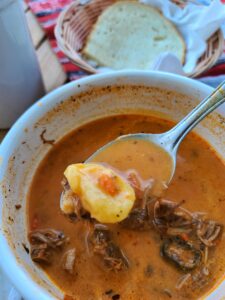
Hangry Backpacker Recommendations
- Casa Wagner – Great local food at this family-run hotel. Sit outside in the square!
- Unnamed Langos Shop – Next to 5 To Go, nice spot for a cheap snack
- Atelier Specialty Coffee – Trendy but good spot for an overpriced coffee and pastry
- Nuvela – This little cafe has cheap wine and great langos
- The bar at MYstical Transylvania – Outdoor bar/garden has local craft beer in a chill setting
- Pensiune Casa Kuhn – This Old Town family-run hotel has good local cuisine, including Hungarian fare
- Helios – Unpretentious outdoor cafe with super cheap beer and snacks. Ignore Google Maps permanent closure update (it is still open)
Travel To/From and In Sighisoara
Sighisoara is easy to reach for tourists. The best way to get to the city is via train. The train station is on the edge of town. It is about 15-minutes walking from the Sighisoara train station to the Historic Center. You can add about 10 minutes if you have bags or stop to snap a photo or two. The walk is easy until you have to walk up the hill. You can expect to break a sweat then.

You can take a taxi if you wish. Romanian taxis are notoriously untrustworthy. Whether this remains true in Sighisoara, I cannot confirm. Either way, I wouldn’t pay more than 10 Lei for the taxi. It’s a short trip.
There are direct trains to/from Sibiu and Brasov. The train from Sibiu takes about two-and-a-half hours. I paid 13 Lei (less than $3 USD). The train to/from Brasov takes about three hours, and I paid 39 Lei (about $6.50 USD). I’m not sure why it was more expensive. This may be because the train from Sibiu was first come, first serve seating, and the train to Brasov had reserved seats. Either way, the trip to Brasov is not much longer or any more comfortable. Both journeys are easy and cheap.
If you are coming from Bucharest, Cluj or another city, you will have to transfer trains somewhere.
You can also take a bus. Buses are more comfortable and usually faster. However, if you are coming from or going to Sibiu, take the train. It is faster and much cheaper. For Brasov, there isn’t as much difference in price/time when comparing train and bus.
Before you travel to Sighisoara, check out the Hangry Backpacker’s Guide to Transportation in Romania for Tourists.
Getting around Sighisoara is easy. Most of the restaurants and sites attracting tourists are central and near the Historic Center. Otherwise, you can walk anywhere you need to go. This is a small city. If you wish to take a taxi, negotiate a price for all passengers COMBINED before you enter the cab.
When is the Best Time to Visit?
The best time to visit Sighisoara is really any time at all. Despite the wonderful sights and deep history in this city, it is a sleepy place. Business and tourists numbers do increase slightly on weekends. If you can visit during the week, you will avoid the crowds.

This is a mountainous area, and it snows during Winter. Personally, I would not want to walk on the steep paths or old, stone streets when they are wet and/or icy.
Summers here are warm and humid. To me, it’s pleasant. Keep in mind, though, that many hotels, especially in Old Town, do not have air conditioning. These are often old buildings, and there isn’t much need for A/C most of the year.
The shoulder seasons (Spring or Fall) are your best bet for travel to Sighisoara in mild weather. You’ll avoid the Summer crowds and the Winter cold.
How Long Should You Stay?
To be frank, there isn’t that much to see or do in Sighisoara. It is absolutely a photogenic place, and there is a ton of history, too. As far as famous attractions and activities, there isn’t a lot.
Despite that, it is a nice place to slowly enjoy and explore. The old city is so well-preserved, you can spend a couple of days enjoying just that and not feel like it’s time to move on.

However, to be fair to travelers who do not have an abundance of time on their hands, let’s be more specific.
Two days is plenty of time to thoroughly see Sighisoara. Truly, you can see what you “need to see” in a day. Two nights and one day will give you enough time.
Three days or more will give you the time to see “everything” and then some. I stayed for 3 days and enjoyed it all. Another day might have been one too many for me. Of course, if you have a rental car, you can explore the surrounding area with any extra time.
Where to Stay in Sighisoara
I prefer to stay in hostels, but Romania is lacking in the hostel department. I found one single hostel in Sighisoara. Unfortunately, it was entirely booked with a school group during my visit.
There are not a lot of hotels in Sighisoara. Most of these are small, family-run hotels. In fact, I recall seeing only a single large hotel and no chain hotels anywhere. Perhaps I missed it, but even an online search yields small hotels.
I thoroughly enjoyed my small hotel. I stayed a few nights at Casa Wagner, which sits directly in Citadel Square. The staff is friendly, and the hotel definitely has an old charm. It’s a time capsule of sorts but in the best way. Casa Wagner also operates one of the restaurants in the square. My food there was delicious.
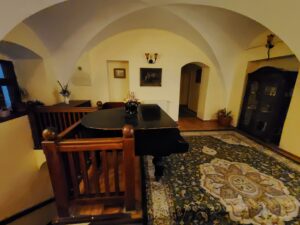
Sighisoara’s efforts of preserving the past in their culture and architecture make it a unique travel destination in Romania. There is no shortage of history, and this is an ideal spot to slow down and enjoy the remarkable scene that is the UNESCO-designated Historic Center.

Sighisoara is an excellent place to travel when you visit Romania. The history is visible along the picturesque streets and medieval surroundings. Even better, this is accompanied by great food and stunning panoramic views. If you’re touring through Transylvania, Sighisoara is a must-visit destination.


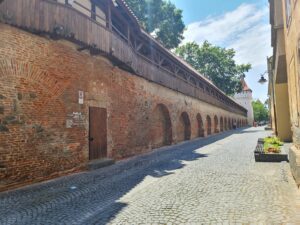
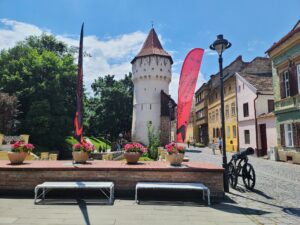
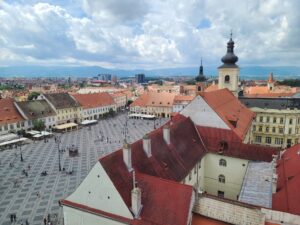
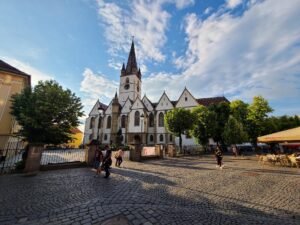
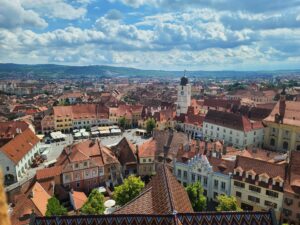
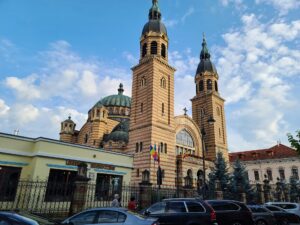
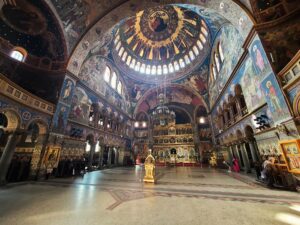
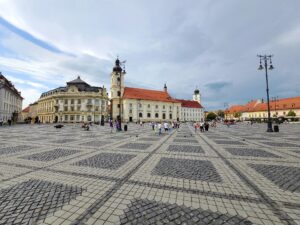

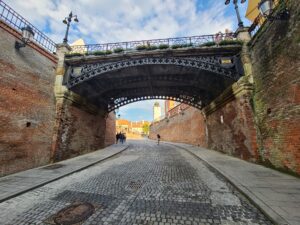
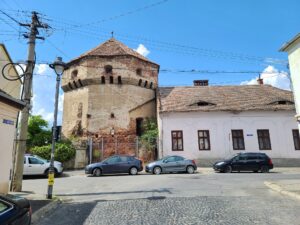



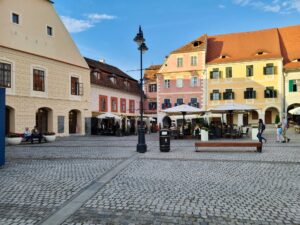

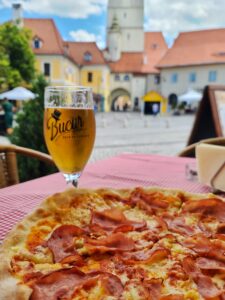
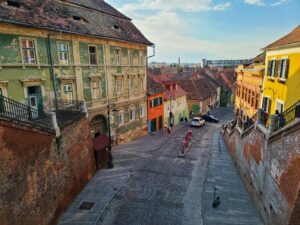








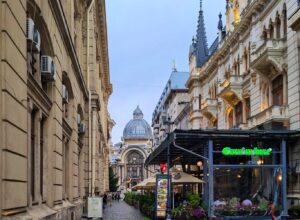


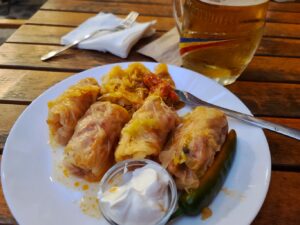
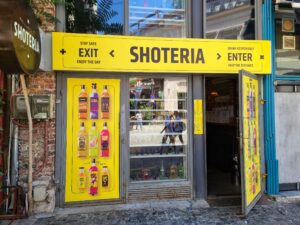

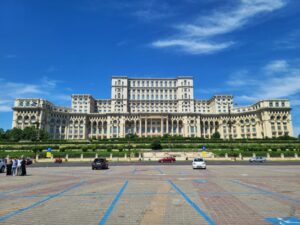
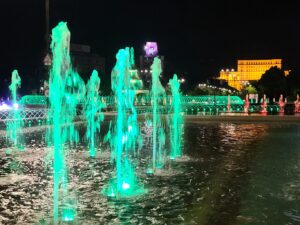




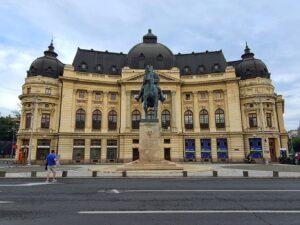

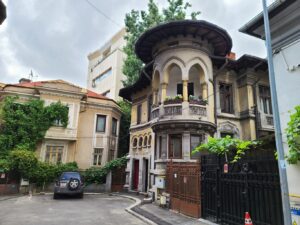

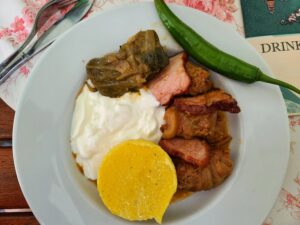














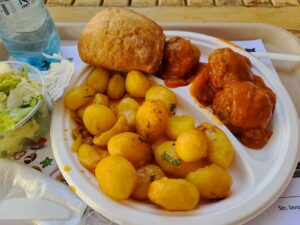
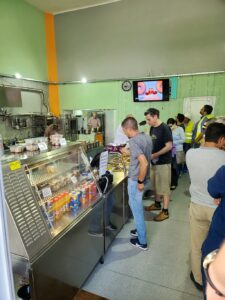
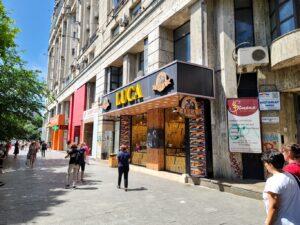
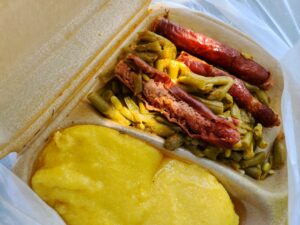







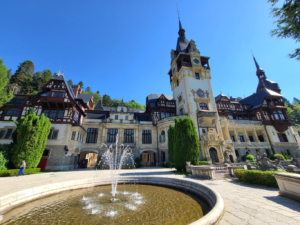


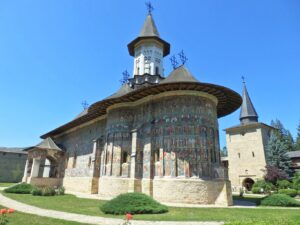





You must be logged in to post a comment.